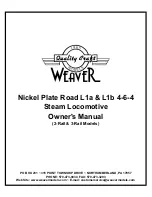
3. Where established, I will abide by the safety rules for the
flying site I use, and I will not willfully and deliberately fly
my models in a careless, reckless and/or dangerous manner.
RADIO CONTROL
1. I will have completed a successful radio equipment
ground range check before the first flight of a new or repaired
model.
2. I will not fly my model aircraft in the presence of
spectators until I become a qualified flier, unless assisted by
an experienced helper.
3. I will perform my initial turn after takeoff away from the
pit or spectator areas, and I will not thereafter fly over pit or
spectator areas, unless beyond my control.
FLYING
The Super Decathlon 40 is a great-looking scale airplane
and a great-flying sport airplane that, true to its full-size
counterpart, is highly acrobatic. It does not have the clean
lines and smoothness of a "pattern ship" nor the self-
recovery characteristics of a primary trainer, therefore you
must either have mastered the basics of R/C flying or seek the
assistance of a competent R/C pilot to help you with your first
flights.
NOTE: We encourage you to fly this airplane only with
the cowl attached, because the cowl streamlines the
airframe and results in much better flying characteristics.
TAKEOFF: Do a low speed taxi test before your first
takeoff. If the plane does not track straight, bend the tailgear
with two pliers. Don't adjust the ground steering with the
rudder trim! Although the S uper Decathlon 40 has good low
speed characteristics, you should always build up as much
speed as your runway will permitbefore lifting off, as this will
give you a safety margin in case of a "flame-out". The big
fuselage has a lot of drag, so don't jerk it to vertical right after
liftoff! Just climb out gradually and let it gain some airspeed
before hunting for the clouds. For safety's sake, always
remember to make your first turn away from the pit area.
FLYING: We recommend that you take it easy with your
Super Decathlon 40 for the first several flights and gradually
"get acquainted" with its flying characteristics as your
engine gets fully broken-in. Work on trimming the airplane
for straight and level flight with the transmitter trims at
neutral, adjusting the nylon clevises after each flight, as nec-
essary. Also, take note of the responsiveness of the elevator,
ailerons and rudder, and adjust their throws to your prefer-
ence. Add and practice one maneuver at a time, learning how
it behaves in each one. If you notice any "sluggishness" in
the way your Super Decathlon 40 handles, it is probably a
result of not enough speed, in which case you should install a
propeller with a larger diameter or increased pitch. We don't
know of any maneuver that this airplane is not capable of
performing; however, you can expect considerable roll cou-
pling with rudder when attempting knife edge maneuvers.
Snap rolls are instantaneous, requiring only a "shot" of
elevator and rudder combined. Full-throttle snaps are not
recommended, due to the extremely high stresses they place
on the structure.
LANDING; Because the Super Decathlon 40 has a lot of
aerodynamic "drag", it will slow down more quickly than
you might expect when you cut the throttle for landing.
Therefore, try to maintain at least a "high idle" during the
landing approach to avoid inadvertently losing flying speed.
Also, because of the high drag, it is not necessary to flare to
a high angle of attack to reduce speed just before touchdown.
If it starts to get" mushy ", get off that up- elevator! As a rule
of thumb (for this type airplane only), if the airplane looks
like it is level, it is probably flared about right for landing.
With a little practice, a little power on, and very little flare,
you'll be "greasin' em in" before you know it!
Have a ball! But always stay in control and
fly in a safe manner.
GOOD LUCK AND GREAT FLYING!
CAUTION (THIS APPLIES TO ALL R/C AIRPLANES):
If, while flying, you notice any unusual sounds, such as a low-
pitched "buzz", this may be an indication of control surface
"flutter". Because flutter can quickly destroy components
of your airplane, any time you detect flutter you must imme-
diately cut the throttle and land the airplane! Check all servo
grommets for deterioration (this will indicate which surface
fluttered), and make sure all pushrod linkages are slop-free. If
it fluttered once, it will probably flutter again under similar
circumstances unless you can eliminate the slop or flexing in
the linkages. Here are some things which can result in flutter:
Excessive hinge gap; Not mounting control horns solidly;
Sloppy fit of clevis pin in hom; Elasticity present in flexible
plastic pushrods; Side-play of pushrod in guide tube caused
by tight bends; Sloppy fit of Z-bend in servo arm; Insufficient
glue used when gluing in the elevator joiner wire or aileron
torque rod; Excessive flexing of aileron, caused by using too
soft balsa aileron; Excessive "play" or "backlash" in servo
gears; and Insecure servo mounting.
40
Summary of Contents for Super Decathlon 40
Page 4: ...DIE PATTERNS Usethis drawing to help you identify the die cutparts 4...
Page 42: ...42...
Page 43: ...43...





































